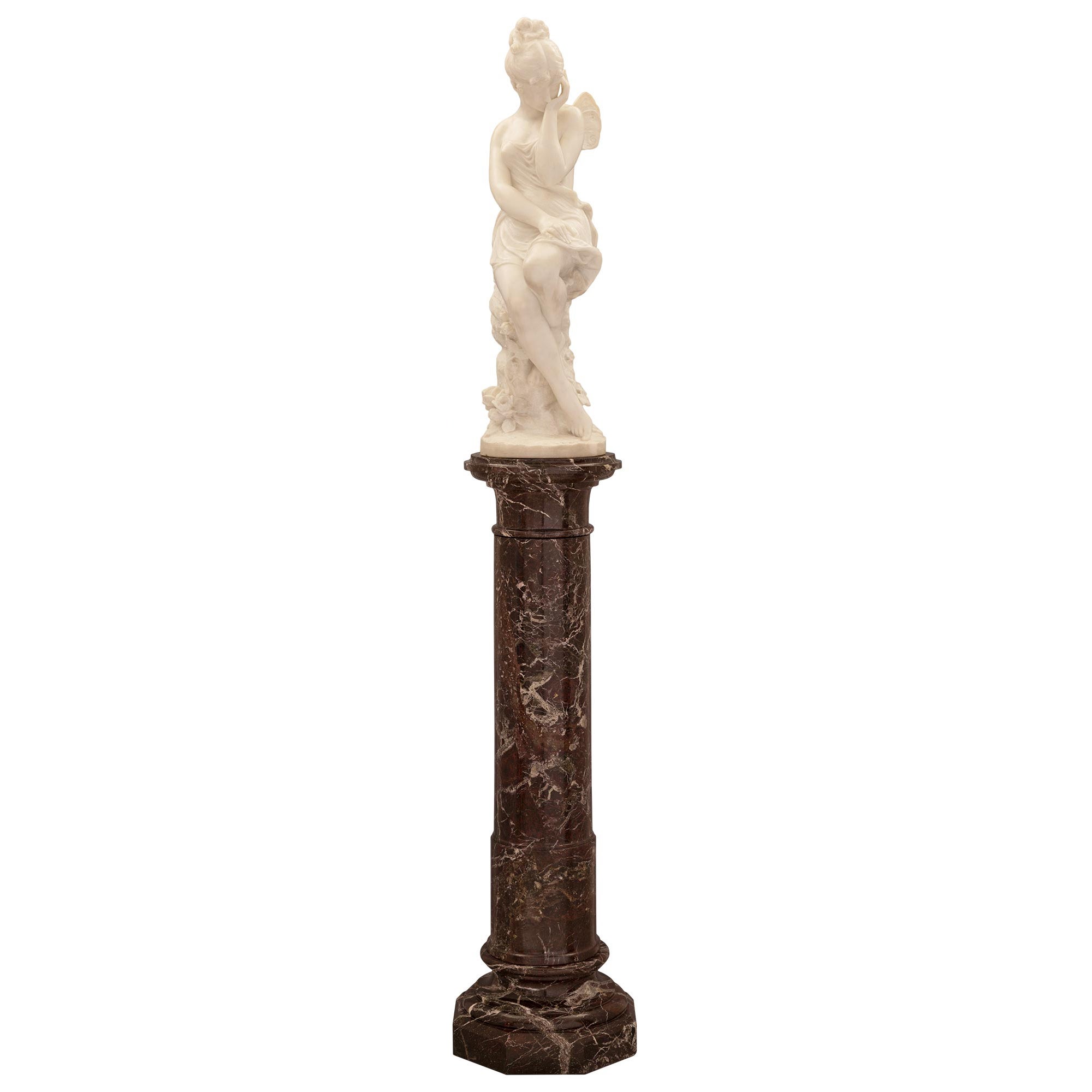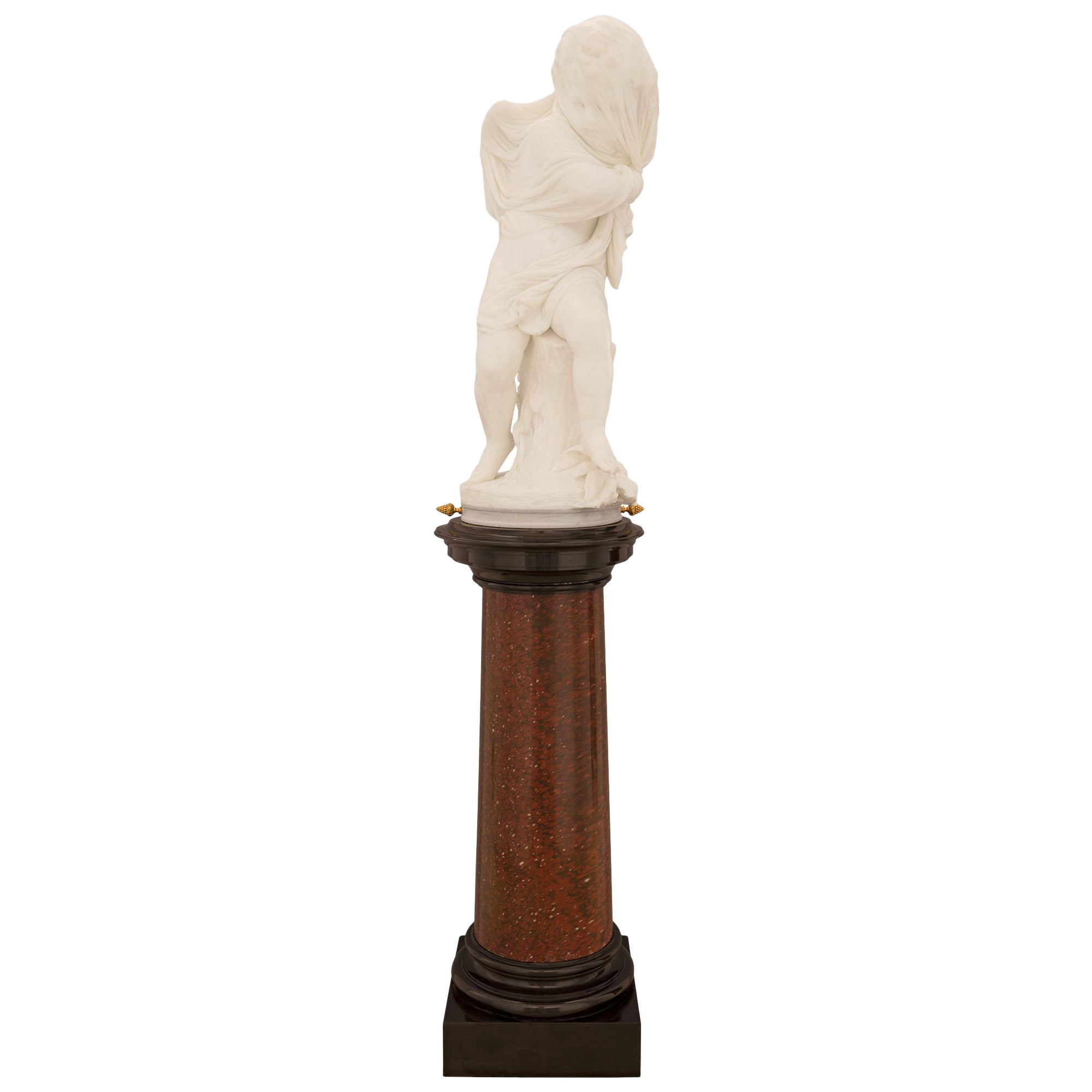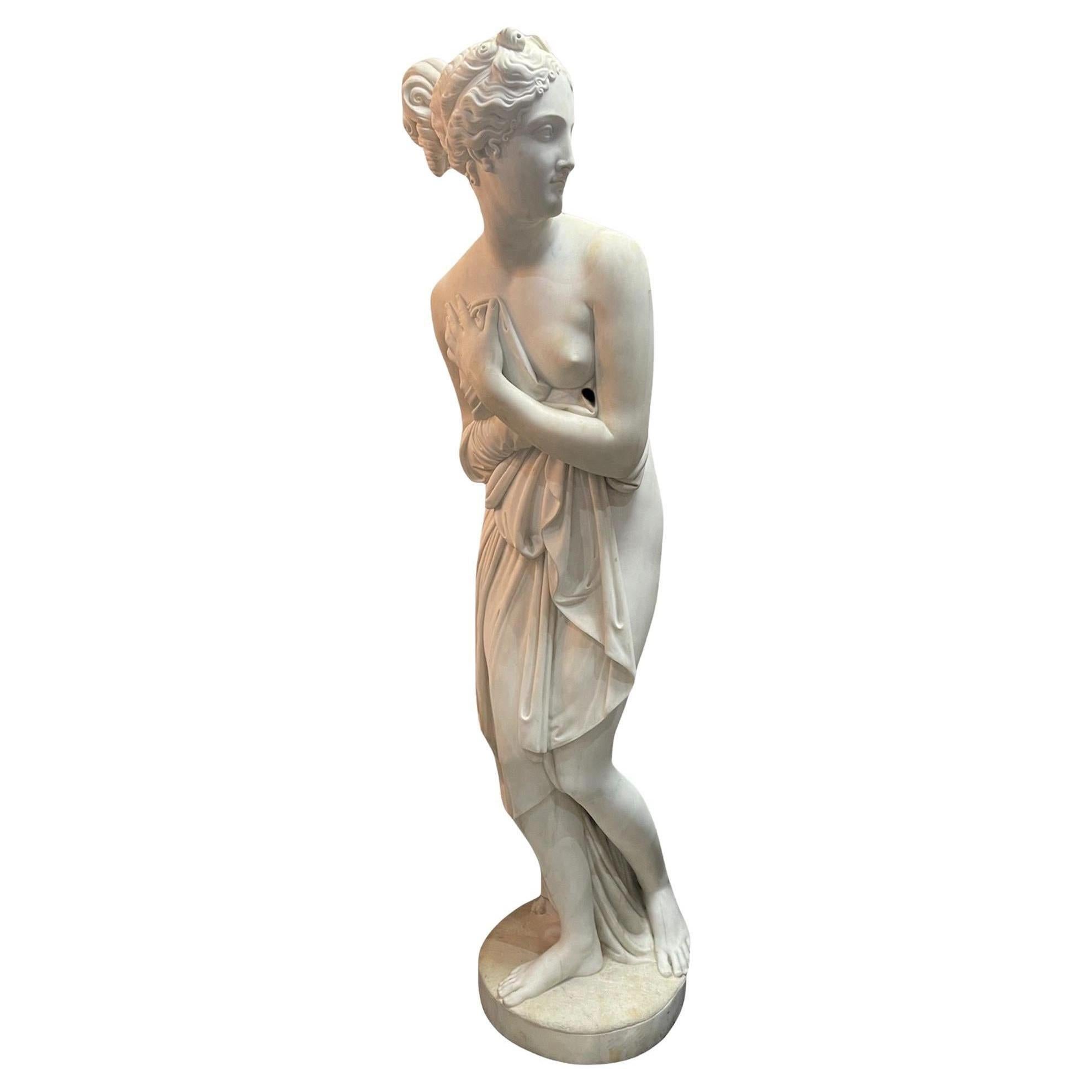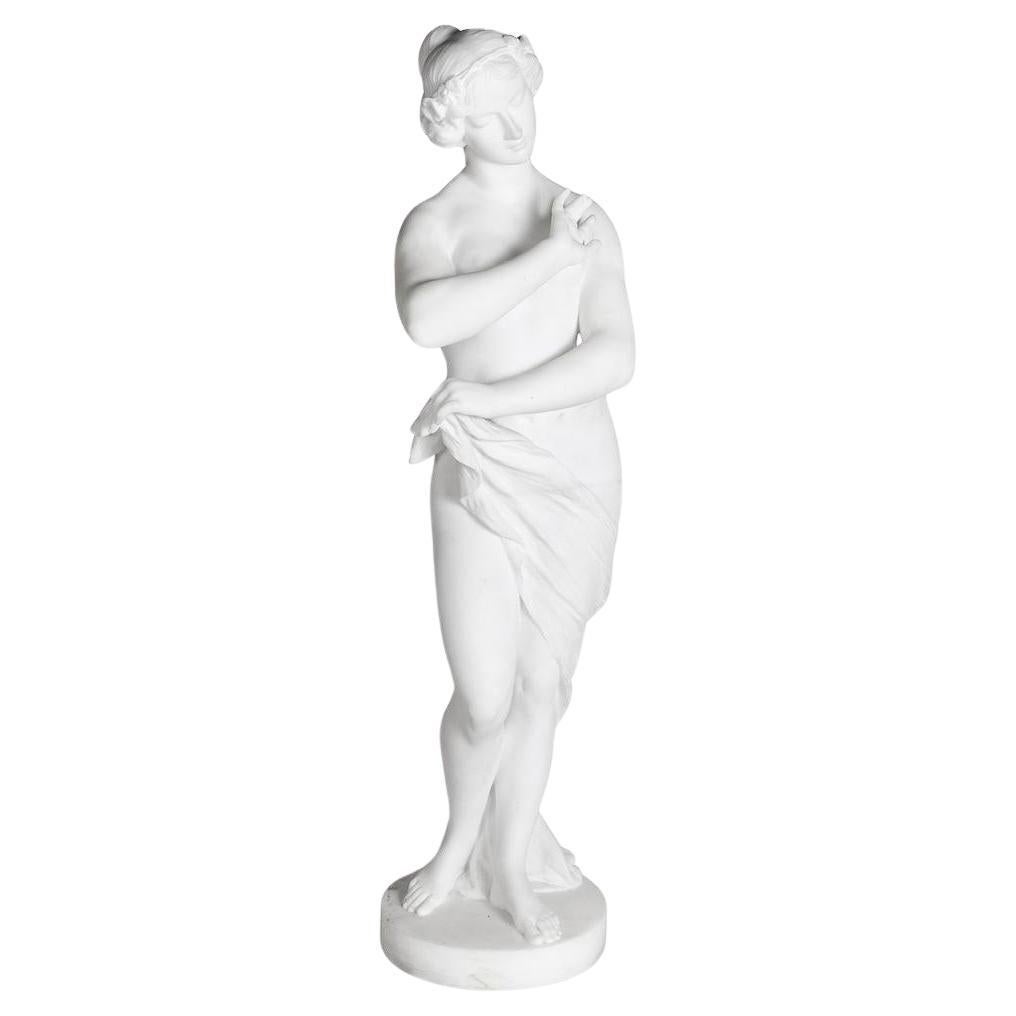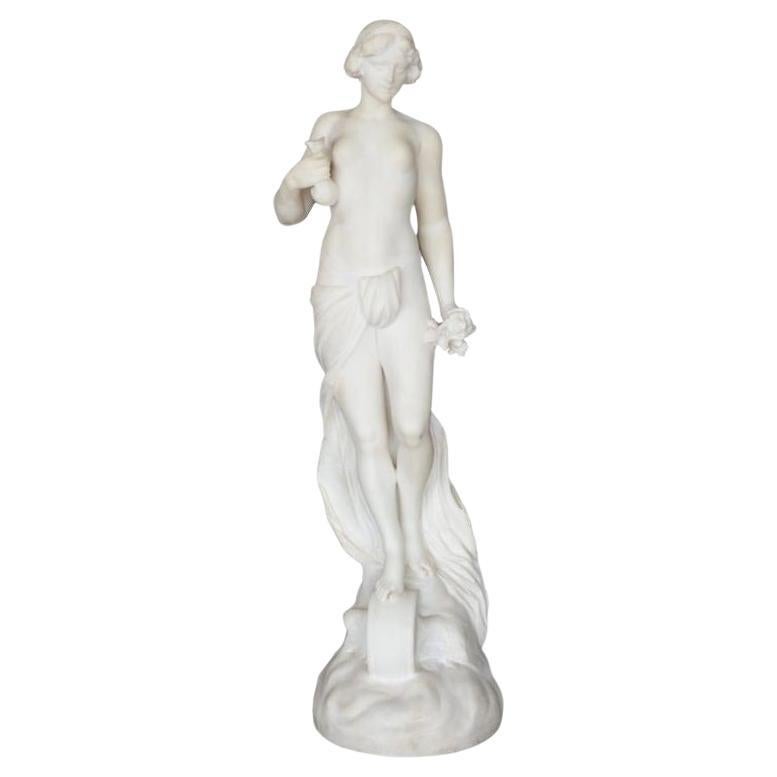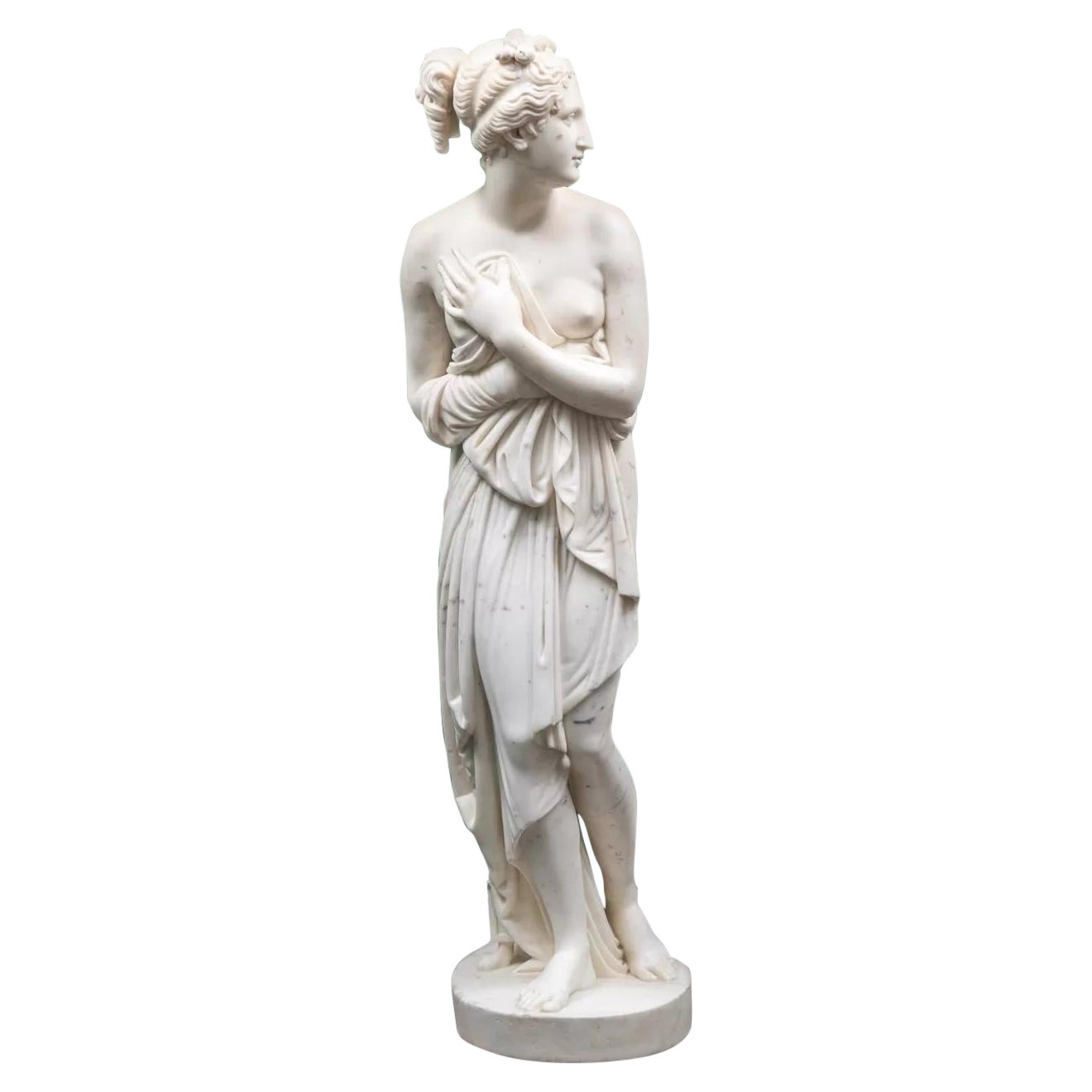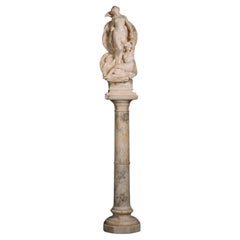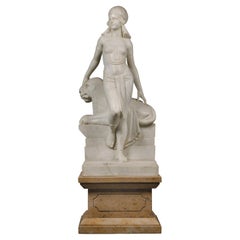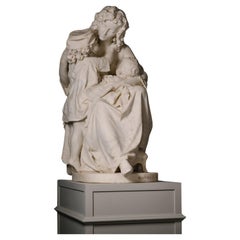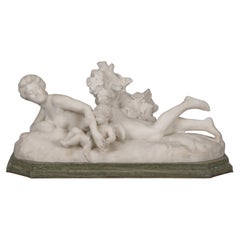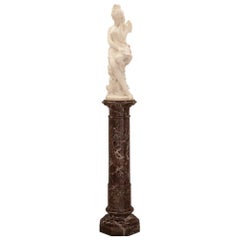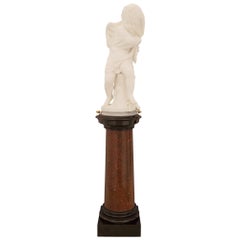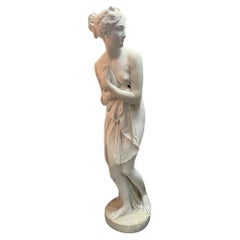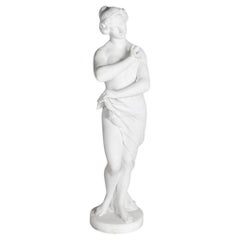Items Similar to A Carrara Marble Statue Of The 'Venus Italica', On Pedestal, After Canova
Want more images or videos?
Request additional images or videos from the seller
1 of 12
A Carrara Marble Statue Of The 'Venus Italica', On Pedestal, After Canova
$55,108.85
£40,000
€46,712.24
CA$76,302.06
A$83,303.58
CHF 43,672.66
MX$1,011,754.06
NOK 545,400.41
SEK 515,003.42
DKK 348,657.14
About the Item
A Fine Carrara Marble Statue Of The 'Venus Italica', On Pedestal, After the Celebrated Model by Antonio Canova.
Venus is modelled looking over her right shoulder holding her robes with her left hand across her chest. A casket at her feet. On a shaped circular base. On a red scagliola column pedestal with white marble foot.
Italy, Circa 1890.
Known as the 'Venus Italica' and considered one of Canova’s finest sculptures, its creation only came about only because Napoleon had plundered from the Uffizi the antique statue known as the 'Medici Venus'. Canova was persuaded by Lodovico I, King of Etruria, to make a replacement so as to redeem its loss and restore national honour. The patriotic overtones of its inception are accented by the name given to the statue. Canova was free to reinterpret Venus and made two variations before finally completing the Venus Italica in 1811. The Grand Duchess of Tuscany, Elisa Baciocchi, actually convinced Napoleon, her brother, to pay Canova the 25,000 francs agreed, so that the statue could be delivered to Uffizi atop the empty pedestal left by the 'Medici Venus'. Comparisons between the two were inevitable, the most famous being that a most beautiful woman had replaced a most beautiful goddess. Its popularity was undeniable, and Canova would complete a second version for Crown Prince Ludwig of Bavaria, now in the Munich Glyptothek and a third version for Prince Lucien Bonaparte, resold to Lord Lansdowne in 1819, and now lost.
In 1815 the 'Medici Venus' was returned to Florence, but in the 19th century the modern Venus would take its place as a more lasting symbolic model of beauty. Its universal fame resulted in an incalculable number of replicas made in the Roman and Florentine studios, either life-size or, as here, reduced. The present example is particularly fine, sculpted from unveined Carrara marble, beautifully detailed and retaining an excellent original interior finish.
This statue once formed part of a collection of valuable 19th century sculpture belonging to the Viscounts Mountgarret at Nidd Hall, North Yorkshire.
Related Literature:
'Canova', Catalog of an exhibition held at the Correr Museum, Venice and the Gipsoteca, Possagno, Mar. 22-Sept. 30, 1992. Marsilio Editori, Venice, 1992, No. 132, pp. 282-289.
Provenance:
Richard Butler, 14th Viscount Mountgarret, Nidd Hall, North Yorkshire.
Thence by descent until sold in 1968 by Richard Butler, 17th Viscount Mountgarret, to Guy Reed at Copgrove Hall, Yorkshire.
The statue: Height 102 cm, Width 30 cm, Depth 35 cm
Pedestal: Height 124 cm, Width 42 cm , Depth 42 cm
Overall 226 cm high.
Weight of statue: 54 kg
Weight of pedestal: 80 kg
Total weight: 134 kg
- Dimensions:Height: 88.98 in (226 cm)Width: 13.78 in (35 cm)Depth: 11.82 in (30 cm)
- Materials and Techniques:
- Place of Origin:
- Period:
- Date of Manufacture:Circa 1890
- Condition:Wear consistent with age and use.
- Seller Location:Brighton, GB
- Reference Number:Seller: B782311stDibs: LU1028046177662
About the Seller
5.0
Recognized Seller
These prestigious sellers are industry leaders and represent the highest echelon for item quality and design.
Established in 1964
1stDibs seller since 2014
58 sales on 1stDibs
Typical response time: 6 hours
Associations
The British Antique Dealers' AssociationLAPADA - The Association of Arts & Antiques Dealers
- ShippingRetrieving quote...Shipping from: Brighton, United Kingdom
- Return Policy
Authenticity Guarantee
In the unlikely event there’s an issue with an item’s authenticity, contact us within 1 year for a full refund. DetailsMoney-Back Guarantee
If your item is not as described, is damaged in transit, or does not arrive, contact us within 7 days for a full refund. Details24-Hour Cancellation
You have a 24-hour grace period in which to reconsider your purchase, with no questions asked.Vetted Professional Sellers
Our world-class sellers must adhere to strict standards for service and quality, maintaining the integrity of our listings.Price-Match Guarantee
If you find that a seller listed the same item for a lower price elsewhere, we’ll match it.Trusted Global Delivery
Our best-in-class carrier network provides specialized shipping options worldwide, including custom delivery.More From This Seller
View AllA Fine Carved Alabaster Group of The Birth of Venus, On Pedestal
Located in Brighton, West Sussex
A Fine Carved Alabaster Group of The Birth of Venus, On Pedestal.
Modelled with Venus standing in an open oyster shell holding the hand of a nymph seated at her feet. On a veined alabaster pedestal.
Italy, Circa 1900.
The Birth of Venus depicts the moment described by the Roman poet Ovid when, having emerged from the sea in a shell, Venus lands at Paphos in Cyprus. Venus, or Aphrodite in Greek mythology, wears a pearl neckless...
Category
Antique 19th Century Figurative Sculptures
Materials
Alabaster
Art Deco Statuary Marble Figure of Cleopatra
Located in Brighton, West Sussex
An Art Deco statuary marble figure of Cleopatra.
The half-lifesize standing figure posed with her right foot raised and looking to dexta, in front of a recumbent sphinx raised on a stepped entablature. On a Siena marble pedestal carved with panelled front.
Italian, Early 20th century.
Intertwining history and legend, the story of Cleopatra (68-30 B.C.) has inspired artists for centuries. The present depiction dates to a period of Egyptomania inspired by Howard Carter...
Category
Early 20th Century Italian Art Deco Figurative Sculptures
Materials
Marble
$39,265 Sale Price
25% Off
An Exhibition Lifesize Statuary Marble Figural Group
Located in Brighton, West Sussex
An Important Lifesize Statuary Marble Figural Group of a Mother and Her Two Children, Entitled 'Mamma ce n'è una sola' (You only have one mother), By Silverio Martinoli (Italain, 183...
Category
Antique 19th Century Italian Victorian Figurative Sculptures
Materials
Carrara Marble
A White Marble Figural Group of Venus and Cupid by Henri Weigele
Located in Brighton, West Sussex
A White Marble Figural Group of Venus and Cupid by Henri Weigele.
Signed ‘H. Weigele’ and titled ‘IL PASSEPA'
Born in Schierbach, Haut-Rhin, Henri Weigele (1858- 1927) studied sc...
Category
Antique 19th Century French Figurative Sculptures
Materials
Marble
‘Mosè Salvato Dalle Acque’. An Important Marble Group By Pietro Bazzanti
By Pietro Bazzanti
Located in Brighton, West Sussex
Pietro Bazzanti (Italian, 1825-1895) - ‘Mosè Salvato Dalle Acque’.
An Important Exhibition Florentine Marble Group of Moses Rescued from the Waters, on a carved Rosso Levanto Pedest...
Category
Antique Late 19th Century Italian Figurative Sculptures
Materials
Marble
A White Marble Figure of a Kneeling Cherub, By Pio Fedi
Located in Brighton, West Sussex
A Fine White Marble Figure of a Kneeling Cherub, By Pio Fedi.
Signed to the base 'Pio Fedi Faceva'.
Italian, Circa 1860.
Pio Fedi (1815-1892) was an Italia...
Category
Antique 19th Century Italian Figurative Sculptures
Materials
Marble
You May Also Like
Italian 19th Century Marble Statue of Psyche on Her Original Pedestal
Located in West Palm Beach, FL
A stunning and very high quality Italian 19th century white Carrara marble statue title Psyche Abandoned on her original Rosso Levanto marble pedestal...
Category
Antique 19th Century Italian Figurative Sculptures
Materials
Marble
Italian 19th Century White Carrara Marble Statue On Its Original Pedestal
By Antonio Rosetti
Located in West Palm Beach, FL
An exquisite and extremely high quality Italian 19th century white Carrara marble statue on its original Rouge Griotte and black Belgian marble pedestal named "Amore Segreto" signed A. E. Rossetti Roma 1878. The statue is raised on its original pedestal column with a square black Belgium marble base and mottled socle shaped support below the circular lightly tapered Rouge Griotte marble central support and circular mottled top. The stunning white Carrara marble statue above depicts a charming young winged cherub, likely Cupid, siting on a tree trunk while draped in a outstanding masterfully sculpted veil. Exceptional attention to detail throughout.
Antonio Rossetti (or Rosetti) was an Italian sculptor producing predominantly statues of nudes and figures. He was born in Milan on 31 October 1819 and moved to Rome in 1843 where he created high quality and very desirable statues also popular among foreign visitors. His works can still be seen in many museums such as the Hermitage Museum, the Glasgow Museums...
Category
Antique 19th Century Italian Figurative Sculptures
Materials
Marble
Life Size Marble Sculpture of Venus After “La Venus Italica”
Located in Guaynabo, PR
This is a life size marble sculpture of Venus after “La Venus Italica” sculpture of Antonio Canova that is at the Palazzo Pitti in Florence. It depicts a...
Category
Early 20th Century Neoclassical Figurative Sculptures
Materials
Marble
$14,400 Sale Price
20% Off
19th Century Marble statue of a classical maiden.
Located in Brighton, Sussex
An enchanting late 19th Century French carved marble statue of a semi nude classical maiden, circa 1890.
Batch 78 62828 SNKZZ
Category
Antique 19th Century French Romantic Abstract Sculptures
Materials
Marble
Late 19th Century Italian Carrara Marble Statue of a Young Lady.
Located in Los Angeles, CA
A delicate and beautifully carved Carrara marble statue depicting a young semi-nude girl, holding a bouquet of roses in one hand and a vase in the other. This late 19th century Itali...
Category
Antique Late 19th Century Italian Figurative Sculptures
Materials
Carrara Marble
Antique statuary Carrara sculpture “Venus Italica” after Antonio Canova
By Antonio Canova
Located in Tyrone, Northern Ireland
An antique Carrara marble sculpture “Venus Italica” after Antonio Canova (1757-1822)
Made in Italy during the 19th century.
When the Medici Venus was forcibly removed from the Tribuna of the Uffizi by Napoleon’s forces, King Louis I of Etruria commissioned Antonio Canova to replace the figure. True to nature, Canova submitted a wholly original figure to rival the antiquity, despite originally being asked to sculpt a copy. Canova’s Venus...
Category
Antique 19th Century Italian Neoclassical Revival Figurative Sculptures
Materials
Statuary Marble
More Ways To Browse
Bavaria Antique
Antique Duchess
Italian Bronze Pedestal
Italian Venus Bronze Sculpture
Venus Italica
Glass Bonsai Tree
Goldscheider Nude
Gorham Bronze
Guiraud Riviere
Hans Dynasty Tomb
Harp Angel
Horseman Sculpture
Iron Maiden
Italian Venus Bronze Sculpture
Juggler Sculpture
Large German Porcelain Figure
Limousin Art Deco
Male Nude Athlete
